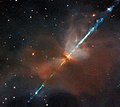Datei:HH111 - HST - Potw2135a.jpg

Größe dieser Vorschau: 675 × 600 Pixel. Weitere Auflösungen: 270 × 240 Pixel | 540 × 480 Pixel | 865 × 768 Pixel | 1.066 × 947 Pixel
Originaldatei (1.066 × 947 Pixel, Dateigröße: 409 KB, MIME-Typ: image/jpeg)
Dateiversionen
Klicke auf einen Zeitpunkt, um diese Version zu laden.
| Version vom | Vorschaubild | Maße | Benutzer | Kommentar | |
|---|---|---|---|---|---|
| aktuell | 12:23, 4. Sep. 2021 |  | 1.066 × 947 (409 KB) | Fabian RRRR | == {{int:filedesc}} == {{Information |description={{en|1='''Astronomy in Action This striking image features a relatively rare celestial phenomenon known as a Herbig–Haro object. This particular Herbig–Haro object is named HH111, and was imaged by Hubble’s Wide Field Camera 3 (WFC3). These spectacular objects are formed under very specific circumstances. Newly formed stars are often very active, and in some cases they expel very narrow jets of rapidly moving ionised gas — gas that is so hot... |
Dateiverwendung
Die folgende Seite verwendet diese Datei: